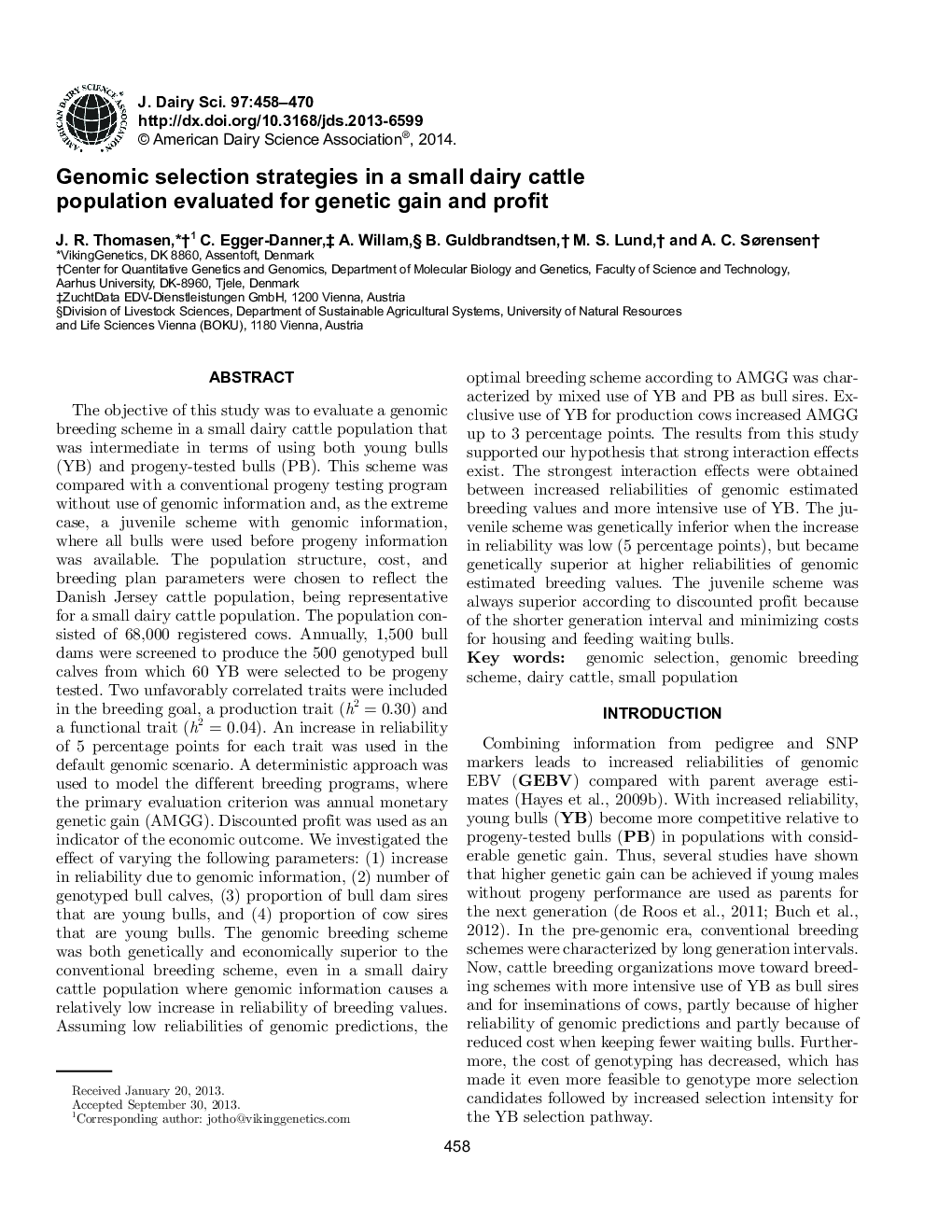| کد مقاله | کد نشریه | سال انتشار | مقاله انگلیسی | نسخه تمام متن |
|---|---|---|---|---|
| 10977772 | 1108052 | 2014 | 13 صفحه PDF | دانلود رایگان |
عنوان انگلیسی مقاله ISI
Genomic selection strategies in a small dairy cattle population evaluated for genetic gain and profit
ترجمه فارسی عنوان
استراتژی های انتخاب ژنومی در یک جمعیت کوچک گاو شیری مورد بررسی قرار می گیرد که برای افزایش و سود ژنتیکی مورد ارزیابی قرار گرفته است
دانلود مقاله + سفارش ترجمه
دانلود مقاله ISI انگلیسی
رایگان برای ایرانیان
کلمات کلیدی
انتخاب ژنوم، طرح اصلاح ژنوم، احشام لبنیاتی، جمعیت کوچک،
موضوعات مرتبط
علوم زیستی و بیوفناوری
علوم کشاورزی و بیولوژیک
علوم دامی و جانورشناسی
چکیده انگلیسی
The objective of this study was to evaluate a genomic breeding scheme in a small dairy cattle population that was intermediate in terms of using both young bulls (YB) and progeny-tested bulls (PB). This scheme was compared with a conventional progeny testing program without use of genomic information and, as the extreme case, a juvenile scheme with genomic information, where all bulls were used before progeny information was available. The population structure, cost, and breeding plan parameters were chosen to reflect the Danish Jersey cattle population, being representative for a small dairy cattle population. The population consisted of 68,000 registered cows. Annually, 1,500 bull dams were screened to produce the 500 genotyped bull calves from which 60 YB were selected to be progeny tested. Two unfavorably correlated traits were included in the breeding goal, a production trait (h2Â =Â 0.30) and a functional trait (h2Â =Â 0.04). An increase in reliability of 5 percentage points for each trait was used in the default genomic scenario. A deterministic approach was used to model the different breeding programs, where the primary evaluation criterion was annual monetary genetic gain (AMGG). Discounted profit was used as an indicator of the economic outcome. We investigated the effect of varying the following parameters: (1) increase in reliability due to genomic information, (2) number of genotyped bull calves, (3) proportion of bull dam sires that are young bulls, and (4) proportion of cow sires that are young bulls. The genomic breeding scheme was both genetically and economically superior to the conventional breeding scheme, even in a small dairy cattle population where genomic information causes a relatively low increase in reliability of breeding values. Assuming low reliabilities of genomic predictions, the optimal breeding scheme according to AMGG was characterized by mixed use of YB and PB as bull sires. Exclusive use of YB for production cows increased AMGG up to 3 percentage points. The results from this study supported our hypothesis that strong interaction effects exist. The strongest interaction effects were obtained between increased reliabilities of genomic estimated breeding values and more intensive use of YB. The juvenile scheme was genetically inferior when the increase in reliability was low (5 percentage points), but became genetically superior at higher reliabilities of genomic estimated breeding values. The juvenile scheme was always superior according to discounted profit because of the shorter generation interval and minimizing costs for housing and feeding waiting bulls.
ناشر
Database: Elsevier - ScienceDirect (ساینس دایرکت)
Journal: Journal of Dairy Science - Volume 97, Issue 1, January 2014, Pages 458-470
Journal: Journal of Dairy Science - Volume 97, Issue 1, January 2014, Pages 458-470
نویسندگان
J.R. Thomasen, C. Egger-Danner, A. Willam, B. Guldbrandtsen, M.S. Lund, A.C. Sørensen,
